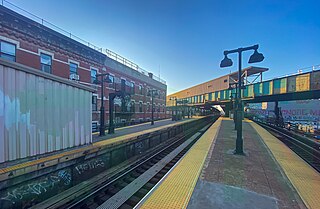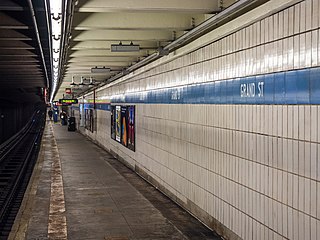The Myrtle Avenue Line, also called the Myrtle Avenue Elevated, is a fully elevated line of the New York City Subway as part of the BMT division. The line is the last surviving remnant of one of the original Brooklyn elevated railroads. The remnant line operates as a spur branch from the Jamaica Line to Bushwick, Ridgewood, and Middle Village, terminating at its original eastern terminal across the street from Lutheran Cemetery. Until 1969, the line continued west into Downtown Brooklyn and, until 1944, over the Brooklyn Bridge to the Park Row Terminal in Manhattan.

The Myrtle Avenue station is a New York City Subway express station on the BMT Jamaica Line. Located at the intersection of Myrtle Avenue and Broadway in Bushwick, Brooklyn. It is served by the J and M trains at all times, and by the Z during rush hours in peak direction.

The Grand Street station is an express station on the IND Sixth Avenue Line of the New York City Subway. Located at the intersection of Grand Street and Chrystie Street at the border of Chinatown and the Lower East Side, it is served by the D train at all times and the B train on weekdays.

The Gates Avenue station is a local station on the elevated BMT Jamaica Line of the New York City Subway, located at the intersection of Gates Avenue and Broadway at the border of Bedford–Stuyvesant and Bushwick, Brooklyn. It is served by the Z train during rush hours in the peak direction and by the J train at all other times.
The Bridge-Jay Street station was a station on the demolished BMT Myrtle Avenue Line in Brooklyn, New York City. It had 2 tracks and 1 island platform. It was opened on April 10, 1888 as Jay Street, and served Myrtle Avenue Line trains as well as the BMT Lexington Avenue Line, and until it was demolished in 1940, the BMT Fifth Avenue Line, which itself also served BMT Culver Line trains. From 1944 until its demolition in 1969, it had a free transfer to the IND Fulton Street and IND Culver lines at Jay Street – Borough Hall. Around that time, it was renamed "Bridge-Jay Street." The next stop to the north was Navy Street for trains traveling on the Lexington & Myrtle Avenue Lines, and Fulton Street other trains until its demolition in 1940. The next stop to the south was Adams Street. The station was closed on October 4, 1969, after a fire on the elevated structure.
The Navy Street station was a station on the demolished BMT Myrtle Avenue Line in Brooklyn, New York City. It had 2 tracks and 1 island platform. The station was originally built on April 10, 1888 for the Myrtle Avenue Elevated trains, but also served Lexington Avenue Elevated trains by 1891. A segment of the Lexington Avenue Line once turned north from here onto Hudson Avenue and York Street on its way to the Fulton Ferry until 1904, when Lexington and Fifth Avenue trains were redirected along Myrtle Avenue west of this station. It closed on October 4, 1969, after a fire on the elevated structure. The next stop to the north was Vanderbilt Avenue. The next stop to the south was Bridge–Jay Streets.
The Adams Street station was a station on the demolished BMT Myrtle Avenue Line and BMT Lexington Avenue Line in Brooklyn, New York City. It had 2 tracks and 2 side platforms. It was opened on February 13, 1888, as "City Hall Station" and closed on March 5, 1944. The next stop to the south was Bridge–Jay Streets. The next stop to the north was Sands Street.
The Vanderbilt Avenue station was a station on the now-demolished BMT Myrtle Avenue Line and BMT Lexington Avenue Line in Brooklyn, New York City. It had two tracks and one island platform. It closed on October 4, 1969, along with the rest of the elevated structure, after a fire. The next stop to the north was Washington Avenue, and to the south was Navy Street.
The Washington Avenue station was a station on the demolished BMT Myrtle Avenue Line and BMT Lexington Avenue Line in Brooklyn, New York City. It was opened on December 4, 1888 and had two tracks and one island platform. The next stop to the north was Grand Avenue, and until 1950, the next stop to the north for trains destined for points on the BMT Lexington Avenue Line was Myrtle Avenue. The next stop to the south was Vanderbilt Avenue for both lines. It closed on October 4, 1969, after a fire on the structure.
The Franklin Avenue station was a station on the demolished section of the BMT Myrtle Avenue Line. The station was located at the intersection of Myrtle and Franklin Avenues in Bedford-Stuyvesant, Brooklyn, New York, United States. The station opened in 1889, and closed in 1969.
The Nostrand Avenue station was a station on the demolished section of the BMT Myrtle Avenue Line. The station was located at the intersection of Myrtle and Nostrand Avenues in Bedford-Stuyvesant, Brooklyn. The station opened in 1889, and closed in 1969.
The Tompkins Avenue station was a station on the demolished section of the BMT Myrtle Avenue Line. The station was located at the intersection of Myrtle and Tompkins Avenues in Bedford-Stuyvesant, Brooklyn. The station opened in 1889, and closed in 1969.
The Sumner Avenue station was a station on the demolished section of the BMT Myrtle Avenue Line. The station was located at the intersection of Myrtle Avenue and Sumner Avenues in Bedford-Stuyvesant, Brooklyn. The station opened in 1889, and closed in 1969.
The Myrtle Avenue station was a station on the demolished BMT Lexington Avenue Line in Brooklyn, New York City. It was opened in May 13 1885 and had two tracks and two side platforms. It was located at the intersection of Myrtle Avenue and Grand Avenue, and had connections to Myrtle Avenue Line streetcars. A segment of the Lexington Avenue Line once ran north from here and turned west on Park Avenue to Hudson Avenue and York Street on its way to the Fulton Ferry until 1891. The Myrtle Avenue Elevated was built nearby in 1888, and Lexington Avenue Lines trains began to shift onto that line southwest of this station. It closed on October 13, 1950, although the other BMT station at that location, Grand Avenue was in operation until January 21, 1953, while the rest of the line southwest of Broadway was operational until November 3, 1969. The next southbound stop was Washington Avenue on the Myrtle Avenue El, but was originally another Washington Avenue station on the Park Avenue El. The next northbound stop was DeKalb Avenue.
The Fulton Street station was a station on the demolished section of the BMT Fifth Avenue Line in Brooklyn, New York City. Served by trains of the BMT Culver Line and BMT Fifth Avenue Line, it had two tracks and one island platform. The station was opened on July 27, 1889, at Hudson Avenue and Fulton Street, and was the northernmost Fifth Avenue Line station before the line merged with the BMT Myrtle Avenue Line. It also had connections to the Fulton Street, DeKalb Avenue, and Flatbush Avenue Line streetcars. The next stop to the north was Bridge–Jay Streets. The next stop to the south was Atlantic Avenue, which still exists today as the Atlantic Avenue–Barclays Center subway station complex. It closed on May 31, 1940.

Sands Street was a station on the demolished BMT Myrtle Avenue Line. It was a large complex with two levels.
Court Street – Myrtle Avenue was a station on the demolished BMT Fulton Street Line. The Fulton Street Elevated was built by the Kings County Elevated Railway Company and this station started service on April 24, 1888. The station had 2 tracks and 2 side platforms. Eastbound trains would stop at Court Street, while westbound trains would stop at Myrtle Avenue. It was served by trains of the BMT Fulton Street Line, and until 1920, trains of the BMT Brighton Line. This station was served by steam locomotives between 1888 and 1899. In 1898, the Brooklyn Rapid Transit Company (BRT) absorbed the Kings County Elevated Railway, and it took over the Fulton Street El, and it was electrified on July 3, 1899. It also had a connection to the streetcar line of the same name. It closed on June 1, 1940, when all service from Fulton Ferry and Park Row to Rockaway Avenue was abandoned, as it came under city ownership.
The Hinsdale Street station was a station on the demolished BMT Fulton Street Line in Brooklyn, New York City, at Pitkin Avenue and Hinsdale Street. It had 3 tracks and 2 side platforms. It opened on November 17, 1918, as a replacement for Eastern Parkway station one block to the west on Snediker Avenue, as part of the Dual Contracts, and had a connecting spur to the BMT Lexington Avenue Line via Manhattan Beach Crossing. It was served by BMT 13 trains until 1940, when they were replaced with BMT 12 trains. It also had a connection to the Bergen Street Line trolleys. It closed on April 26, 1956, along with the rest of the remaining segment of the Fulton Elevated Line west of Hudson Street. The station was not replaced with an underground IND Fulton Street Line station, which runs north along Pennsylvania Avenue towards Broadway Junction; the nearest existing station is Sutter Avenue on the BMT Canarsie Line.







